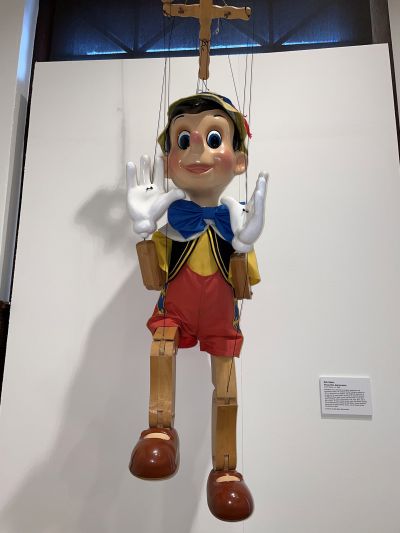L'articolo è un confronto tra la storia originale di Pinocchio scritta da Carlo Collodi nel 1883 con la versione realizzata dalla Disney nel 1940. Lo scrittore spiega che nella storia originale, ogni volta che Pinocchio era cattivo, aveva conseguenze pessime. In questa storia, Pinocchio è stato derubato, rapito, pugnalato, frustato, affamato, imprigionato, preso a pugni in testa, maltrattato fisicamente e psicologicamente e infine ucciso. La storia serve a descrivere cosa succede ai bambini che non si comportano bene e non sono buoni. Al contrario, nella versione Disney, Pinocchio mente molto e ad ogni bugia gli cresce il naso. Pinocchio in diverse situazioni non ascolta suo padre Geppetto e ovviamente racconta bugie. Piano piano, con l'aiuto del suo amico Grillo Parlante, Pinocchio diventa un bravo ragazzo e impara ad essere buono. Pinocchio simboleggia il coraggio, l'onestà e l'educazione. Simboleggia anche come ogni persona è capace di cambiare in meglio. Alla fine, la Disney ha cambiato la storia di Collodi in modo che fosse sensibile e carina senza la bruttezza che si trova nell'originale.
IAMLA (Italian American Museum of Los Angeles) is presenting the exhibit, “A Real Boy: The Many Lives of Pinocchio,” from now through October 2023. Pinocchio is a fictional character created by Carlo Collodi in his children’s novel, “The Adventures of Pinocchio,” written in 1883. It’s a classic piece of children’s literature and has been translated into over 250 languages, making it the most translated book after the Bible.
Collodi’s story is set in a Tuscan village, where Geppetto, a woodcarver, created a wooden puppet named Pinocchio. Unlike a typical wooden toy, he is animated and sentient. Moreover, he is a “rascal,” mischievous and wayward, and even his father, Geppetto, refers to him as a “wretched boy.” As soon as he is born, he steals Geppetto’s wig and laughs mockingly at him. He is swayed by peer pressure, hangs out with bad company and is prone to lying.
Pinocchio’s bad behavior was not funny or charming; Collodi meant for it to be a warning. The story ends in tragedy and is indeed very dark and meant to serve as a lesson for kids who were naughty. In Collodi’s original story, through Pinocchio’s carelessness, he is robbed, kidnapped, stabbed, whipped, starved, jailed, punched in the head, physically and psychologically abused, and eventually loses his life.
Collodi wrote, “His breath failed him, and he could say no more. He shut his eyes, opened his mouth, stretched his legs, gave a long shudder, and hung stiff and insensible.” The end. Pinocchio was a rotten kid. Bad things happen to bad children. He got what he deserved.
He first published a series on Pinocchio in June 1881 in the children’s magazine Il Corriere dei Piccoli. The series was very popular yet shocking to the young readers due to Pinocchio’s tragic demise. Collodi’s publisher convinced him to write a second half where Pinocchio is brought back to life. Pinocchio has further adventures but also experiences more bizarre punishments. But, with the help of a beautiful child with blue hair (later to become the Blue Fairy), Collodi gave Pinocchio a desire to be more responsible. He redeems himself by saving his father. And he gets his wish to be a real boy.
Collodi’s original version is not what most of us remember. We remember him as a cheerful little puppet who wants to become a real boy someday. That is Disney’s whitewashed adaptation, released in 1940. Disney thought that the original version was unsuitable for children, so he proceeded to make changes. For instance, in the original book, when the talking cricket scolds Pinocchio for rebelling against his father, Pinocchio bashes the insect’s brains out with a hammer. In Disney’s version, the cricket becomes a main character, Jiminy Cricket, who serves as Pinocchio’s conscience. And in the original, a single scene in which Pinocchio’s nose grows when he tells a lie becomes a central theme that everyone remembers. Collodi’s moral is that if you behave badly, and do not obey adults, you will be bound, tortured, and killed. Disney transformed that into bravery, truthfulness, and listening to your conscience will be your salvation.
The book gained fame around the world in 1940, when the Disney film was released. Pinocchio is a cultural icon interpreted in many ways and in various media. For example, Astro Boy, from a Japanese comic book series, was inspired by Pinocchio and his adventures. He serves as inspiration for musicians as well, and “I’ve Got No Strings” has been covered by many recording artists in numerous genres.
Carlo Collodi’s real surname was Lorenzini. He chose the pseudonym, “Collodi” because he had fond memories of his childhood in the village of Collodi, Tuscany where there is now a Pinocchio theme Park and the world’s tallest Pinocchio statue measuring 52.5 feet tall. It’s a must-see for anyone who has children…or not!
My favorite current use of Pinocchio is how The Washington Post uses images of Pinocchio to rate the honesty of political statements in the media. There is a range of one to four “Pinocchios” in its Fact Checker column. One “Pinocchio” is given for a minor misstatement of the facts, while four “Pinocchios” are for blatant lies. The “Geppetto” image is awarded to a politician for a truthful statement.
How many parents have scolded their child while saying, “Don’t lie to me or your nose will grow!”? “The Adventures of Pinocchio” may have started as a cautionary tale to encourage children to respect their parents, but it is so much more than that. Themes like being different and feeling out of place, allowing yourself to be taken advantage of, child trafficking, peer pressure, trying to be accepted, and what it means to be “real,” are topics addressed in “The Adventures of Pinocchio” that are pervasive in our society. Pinocchio’s story resonates with all of us in some way!
https://www.lagazzettaitaliana.com/history-culture/10254-the-adventures-of-pinocchio-tragedy-or-transformation#sigProId7200373d30




